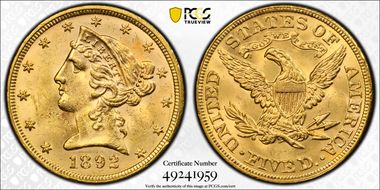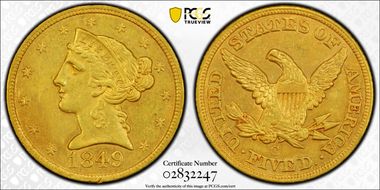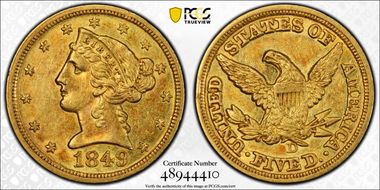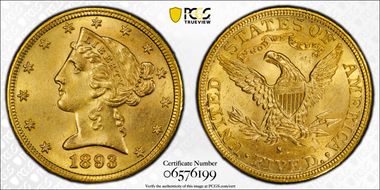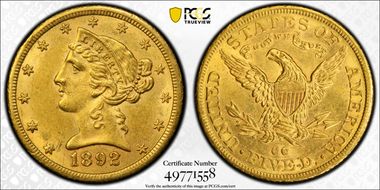Ancestry Half Eagles 的钱币相册
The 1849-C is the most available Charlotte half eagle produced prior to 1850. It is often compared to the 1848-C due to similar mintage but the 1849-C is more readily available, especially in higher grades. The 1849-C is among the more common half eagles from this mint. It is relatively easy to locate in Very Fine ad Extremely Fine grades and can be found in the lower About Uncirculated grades without a huge effort. It is scarce in the higher AU grades and rare in Uncirculated... STRIKE: This is among the best struck half eagles from this mint. As a result, the 1849-C is very popular with type collectors who are seeking a single, well-produced example of this denomination. The detail on the obverse is actually comparable to that seen on Philadelphia half eagles of this era. The hair detail is typically sharp with the exception of the curls below LIB in LIBERTY which range from soft to very soft. On most examples, the stars have full radial lines and the denticles are individually defined. The reverse is well detailed as well. The legs and claws of the eagle are usually full and the neck feather and shield are sharp. The only area that sometimes shows weakness is the tip of the eagle’s right wing.
The 1849-D half eagle is very similar in rarity to the 1848-D. Like the 1848-D, it is a coin whose true rarity (especially in high grades) has not yet been fully acknowledged. The 1849-D half eagle is usually found in Very Fine to Extremely Fine grades. It is sometimes seen in About Uncirculated-50 but it is quite rare in any About Uncirculated grade above this. In full Mint State, the 1849-D is an extremely rare coin. STRIKE: The 1849-D is one of the last half eagles from this mint which can be consistently found with an acceptable strike. Most have better overall definition on the obverse than on the reverse. The area on the obverse which is most likely to show weakness is the curls below IBER in LIBERTY. The rest of the detail is usually sharp, including the stars and denticles. The reverse is often somewhat weak on the tips of the wing, the lower part of the neck and the right leg and claw. SURFACES: A number are known which show mint-made areas of granularity. Most are heavily marked but it is possible to locate an 1849-D half eagles which is not covered with detracting abrasions. LUSTER: The luster tends to be frosty in texture. A few are known which are slightly reflective in the fields. COLORATION: Original, uncleaned pieces show coloration which ranges from medium green-gold to deep orange-gold. Most have been cleaned or dipped and no longer show original coloration. EYE APPEAL: Compared to some of the other Dahlonega half eagles of the 1840’s, the 1849-D shows above average eye appeal. There are a number of well struck, attractive examples in existence. PERSONAL OBSERVATIONS: The 1849-D half eagle is a reasonably common coin in most circulated grades but it is extremely rare in Uncirculated. As with the similarly dated quarter eagle, it may be overlooked due to the 1849-D gold dollar being fairly available in Uncirculated. DIE VARIETIES: Three die varieties are currently known. Variety 21-N: On obverse, the date is not as well centered as on the next variety and is positioned higher in relation to the neck. The reverse is the same as described for Variety 19-N, except that there is absolutely no trace of the mispunched mintmark. It is not known which of the two 1849-D half eagle varieties is rarer. Variety 22-L: On the obverse, the date is well centered in the space between the neck and the denticles. The reverse has a high mintmark that touches both the stem and the feather. The left edge of the mintmark is over the center of the right diagonal of the V in FIVE. Variety 22-N: This is a newly discovered variety that combines the obverse and reverse dies listed above. It appears to be very rare. This is a very rare date in all grades, more so than the D Mint coins from 1843 to 1847 and roughly comparable to the 1848-D and 1850-D. It is much more rare as a date than the 1851-D, 1852-D, 1853-D and 1854-D and it has actually had fewer auction appearances than some of the
The 1893-S is a moderately scarce date in all grades, although it is not as difficult to obtain in choice condition as the 1892-S or the four S Mint coins immediately following (1894-1897). It should not be grouped with the common dates of the series since it is really quite scarce in strictly uncirculated condition, and very scarce in gem condition.
The 1892-CC is one of the most common CC-Mint Half Eagles, and it is far less common than the 1891-CC. Less than twenty percent of the examples certified by PCGS are Mint State, and most of those are either MS62 or MS63. The low grades are usually the result of excessive bagmarks, caused by careless conveyance as they travelled cross-country. The very best example is an NGC MS66, believed to be the former PCGS MS65 from the 1/1990 Superior sale, where it set a record price that has not yet been beat The 1892-CC is one of the most common Carson City Half Eagles and is approximately equal in overall rarity to the 1882-CC, 1890-CC and 1893-CC. It is decidedly more rare than the relatively common 1891-CC. Although uncirculated examples are occasionally available, VF or EF specimens are the most often encountered. Choice or gem quality pieces are rare and are seen less often than comparable quality coins dated 1890-CC or 1893-CC.




















